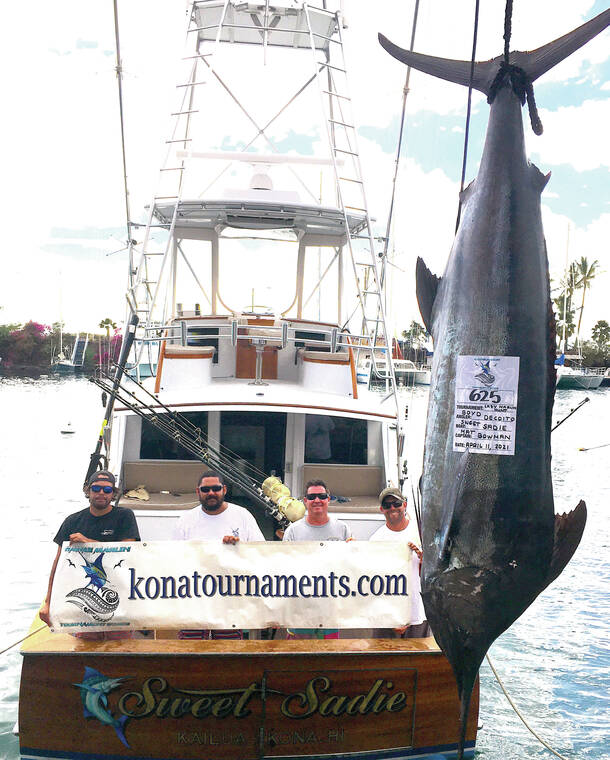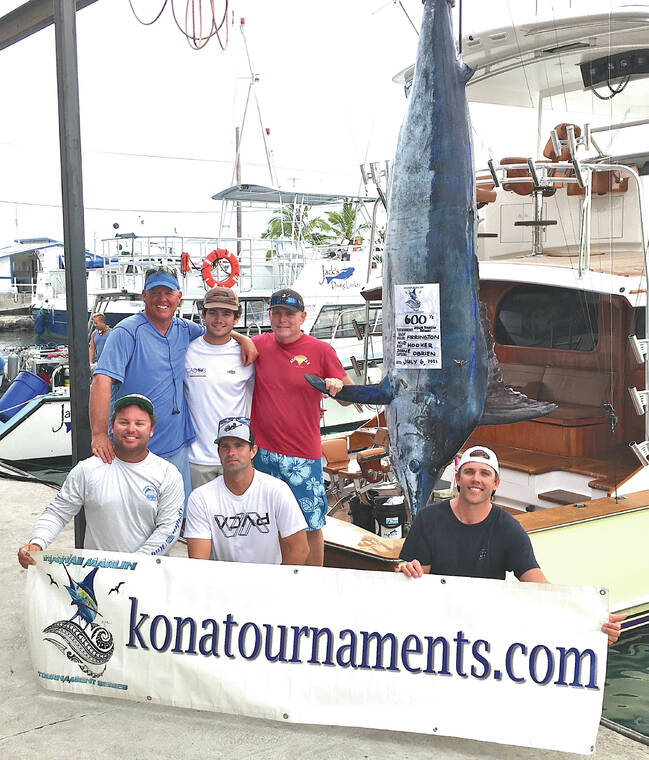The aloha in that
The first day of fall has come and gone and the last “major” fishing tournament of the year is pau. Together, these two mile markers signal the end of the tournament trail. Of course, here in Kona that doesn’t mean an end to fishing. Fishing goes on year round, but certain seasons are just better for some than others. Make a rule about fish, however, and they will make a liar out of you.
A look at the 2021 Big Fish List at the Kona Charter Desk at Honokohau lends insight into this year round nature. The largest blue marlin to date was a coveted “grander” caught May 30 on board Sundowner with Capt. Kevin Hiney. This behemoth weighed in at 1,028 pounds.
The largest black marlin to date was a snowbird, landed on February 25. It weighed 268 pounds and was brought in by Humdinger.
Generally speaking, Mahi Mahi like riding waves in with the wind, especially during winter cold fronts, remaining through the blustery spring. The largest of 2021 is a solid bull of 48 pounds, subdued on Kona Cowboy, March 6.
Ono are also caught year round, but tend to school up in spring. The largest this year tipped the scales at a hefty 68 pounds on May 26. This ripper was brought in by Lahoma’ K.
Yellowfin tuna, known locally as “ahi,” spawn in Kona waters during summer but each season is a bit different. The largest one this year at the Charter Desk was a respectable 183.5-pounder on Kaiolu, caught on August 8.
The largest bigeye tuna was also a summer fish, landed on June 27 from Leilani. Weighing in at 191 pounds, this bruiser is the largest tuna known by the Charter Desk.
Many of the fish caught sustainably by local “small boat” commercial guys throughout the year get weighed at the fish house, not the Fuel Dock. So larger fish could have easily been recorded there.
Striped marlin can run in packs during the cooler months. By summer, stripes are usually lonesome stragglers, if you find them at all. Largest to date is a very nice 161-pounder landed from Bite Me 6 on May 5.
Unfortunately, scientists have stated that the commercial longline fishing industry has overfished “stripies” down to the point where they are officially classified as “depleted.” Federal and international mandates to rebuild the stocks have been discussed but the solution that was proffered was found deficient by National Marine Fisheries, and the process now languishes. In a nutshell, the Fishery Council kicked it back to NMFS to decide how to enforce their own rules, as mandated by U.S. Congress.
While nothing gets done, longline marlin landings have actually gone up while small boat catches have dwindled, and it’s not just striped marlin. Between 2005 and 2013, the longline landings of blue marlin averaged 4,188 per year. Between 2014 and 2019, their average landings almost doubled – from 4,188 to 7,953. In 2019 alone, they killed 12,733 blue marlin.
Tournaments are hugely popular along the Kona Coast, and catch hundreds of marlin each summer. However, even if tournaments brought every single marlin to the dock to be weighed, this year it would only have been about 300. That sounds like a lot, but when you compare it to the 2019 commercial catch of 19,921 striped marlin and 12,773 blue marlin landed by the Hawaii longline fleet (total 32,694) it is a literal drop in the bucket.
Think about it: 300 + 32,694 = 32,994. Just 1% of the combined total 32,994 would be 329 marlin. The Hawaii Marlin Tournament Series tourneys landed only 11 blues this year – about 3% of 329 – a tiny fraction of 1% of 32,994.
The HMTS tournaments teams caught 226 marlin this summer, tagging 215. That is a tag and release rate of 95.2%. The 2021 HMT Series Champions on Wild Hooker caught 29 blue marlin, of which they tagged 26.
Out of 295 marlin caught in 2019, only nine were weighed. That’s a release rate of 97%. Bwana was Champion Boat in 2019, and they caught 34 marlin, weighing only one.
Imagine how happy Kona tournament anglers would be if they caught even 500 a summer! At 95% tag and release, that would still only be 25 marlin landed.
How can one fishing sector be conservation oriented while another sector overfishes the very same fish the first one needs? Indeed.
As Paul Harvey used to say, “And now, for the rest of the story.” Hint: 3rd grade.
The NOAA/NMFS website posts this fun fact: In 2019, commercial landings of Pacific blue marlin from the waters around Hawaii totaled more than 3.7 million pounds and were valued at more than $2.6 million, according to the NOAA Fisheries commercial fishing landings database.
Divide $2.6 million by the 12,733 blue marlin killed by the Hawaii longline fleet and average value is only $208.00 each. Fish can make a liar out of you but government statistics won’t. The $2.6 million is a NOAA number and the 12,733 number is a NMFS number. The $208.00 is a 3rd grade math number.
In 2019 Kona tournament anglers spent more than $2.6 million dollars on tournament entry fees and charter boats, not to mention hotels, meals, rental cars etc. – all to harvest only nine blue marlin. Using the same 3rd grade math, those nine blue marlin value out at $288,888.88 – each!
$288,888.88 vs. $208.00 per fish. A 3rd grader could figure out which is best/highest use of a public resource.
Commercial fishing is not bad, and has a long history in Hawaii. The local small boat commercial sector is, in fact, a poster child of sustainable fishing.
Industrial scale sector monopolization – however – while overfishing to the point of depletion, is not sustainable. Nor is it historically, traditionally or culturally correct – Pono.
Where’s the Aloha in that?
There is absolutely nothing in place to keep striped marlin like depletion from happening to blue marlin and the other species local fishermen need. Science of ono, mahi and spearfish stocks is nil.
The real question is, therefore, “What can be done?”
To learn more about what can be done, drop a line to konafishwatch@gmail.com



